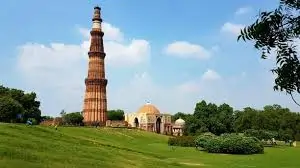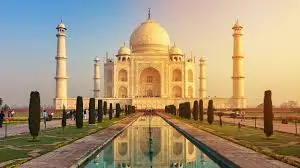The Gateway of India in Mumbai, Maharashtra, is an iconic arch monument built in 1924 to commemorate the visit of King George V and Queen Mary, symbolizing India’s colonial history and architectural grandeur.
ADVERTIDEMENT

Table of Contents

Gateway of India (Mumbai, Maharashtra)
The Gateway of India, located in Mumbai, Maharashtra, is one of the most iconic landmarks in India, representing a blend of colonial history and architectural grandeur. Built in 1924, the monument was commissioned to commemorate the visit of King George V and Queen Mary to India in 1911. Designed by George Wittet, the structure is an excellent example of Indo-Saracenic architecture, combining elements of Hindu and Muslim design with European influences.
Standing majestically on the waterfront of the Arabian Sea at Apollo Bunder, the Gateway of India is an imposing structure, rising to a height of 26 meters (85 feet). Constructed with yellow basalt and reinforced concrete, the monument features intricate latticework and a central dome, making it a visual masterpiece. It served as the ceremonial entrance for British governors and officials arriving by sea and was also the symbolic exit point for the British in 1948, marking the end of colonial rule in India.
The Gateway of India holds immense cultural and historical significance. It is a popular tourist attraction, offering stunning views of the sea and serving as a starting point for ferry rides to the nearby Elephanta Caves, another UNESCO World Heritage Site. The open plaza around the monument is a bustling hub for locals and visitors, with food stalls, photographers, and vibrant street life.
Today, the Gateway of India stands as a symbol of Mumbai’s cosmopolitan spirit and colonial past. It is a must-visit destination for history enthusiasts, architecture lovers, and travelers seeking to experience the vibrant culture and historical legacy of Mumbai, often referred to as the “City of Dreams.”
I. Introduction
The Gateway of India, located in Mumbai, Maharashtra, is a landmark that symbolizes both the grandeur of British colonial rule and the vibrant spirit of Mumbai, often called the “City of Dreams.” This iconic monument, built in 1924, commemorates the historic visit of King George V and Queen Mary to India in 1911. It stands as a testament to the fusion of cultures and architectural styles that define Mumbai’s heritage. Today, the Gateway of India is one of the city’s most visited attractions, serving as a symbol of Mumbai’s historical and cultural significance, and a starting point for exploring its rich maritime legacy.
II. Historical Background
Commissioning
The foundation stone for the Gateway of India was laid in 1913, and its construction was completed in 1924. The British envisioned the monument as a ceremonial entrance to India for visiting dignitaries arriving by sea. Designed by George Wittet, a prominent British architect, the Gateway became an emblem of colonial prestige.
Role in Colonial Era
The Gateway served as a grand ceremonial portal for British governors, viceroys, and other officials. It was intended to project the might and permanence of the British Empire. However, its symbolic role shifted in 1948, when it became the departure point for the last British troops leaving India, marking the end of colonial rule. This transformation imbued the monument with a new significance, as a marker of India’s independence and resilience.
III. Architectural Features
Design
The Gateway of India was designed in the Indo-Saracenic architectural style, which blends elements of Hindu, Islamic, and European architecture. The structure features intricate latticework, ornate archways, and a grand central dome, representing the confluence of cultural influences.
Structure
Standing at 26 meters (85 feet) tall, the Gateway is constructed from yellow basalt and reinforced concrete, giving it both durability and elegance. Its central arch is 15 meters high, surrounded by intricately carved pillars and sculptures that add to its majestic appearance.
Location
Positioned at Apollo Bunder on the southern tip of Mumbai, the Gateway overlooks the Arabian Sea. Its strategic location offers stunning views of the waterfront, making it an iconic backdrop for photographs and a significant part of Mumbai’s skyline.
IV. Cultural and Historical Significance
Historical Importance
The Gateway of India stands as a reminder of Mumbai’s colonial past and its transformation into a global metropolis. Its role as the entry and exit point for British officials symbolizes the changing tides of history, from colonial dominance to India’s independence.
Tourism
As one of Mumbai’s most visited landmarks, the Gateway attracts millions of visitors annually. Tourists are drawn to its historical significance, architectural beauty, and the lively atmosphere surrounding it. It is also the starting point for ferry rides to Elephanta Caves, a UNESCO World Heritage Site known for its ancient rock-cut temples.
Local Importance
For locals, the Gateway of India is more than a historical monument; it is a gathering place and a cultural hub. The open plaza surrounding the monument is bustling with activity, including street performers, vendors selling local snacks, and photographers offering keepsakes. It is also a popular spot for leisure, reflection, and celebrations.
V. Tourism and Modern Relevance
Visitor Experience
The Gateway of India provides visitors with a unique experience of Mumbai’s maritime heritage and cultural vibrancy. From its architectural grandeur to its stunning views of the Arabian Sea, the monument is a must-visit for history buffs, photographers, and travelers. The area around the Gateway is lively, with food stalls, cultural performances, and opportunities to interact with locals.
Nearby Attractions
Located in the heart of Mumbai, the Gateway is close to several other iconic landmarks. These include the Taj Mahal Palace Hotel, a historic luxury hotel known for its architectural beauty, and Colaba Causeway, a vibrant street market offering an eclectic shopping experience. Together, these attractions make the Gateway of India a focal point for exploring Mumbai’s diverse culture.
VI. Challenges and Preservation
Environmental Impact
The Gateway of India faces challenges from urban pollution, exposure to salty sea air, and the wear and tear caused by millions of visitors. These factors have led to discoloration and erosion of the monument’s basalt stonework over time.
Preservation Efforts
Efforts to preserve the Gateway include regular maintenance by local and national heritage authorities. Restoration projects aim to clean and repair the monument while protecting its structural integrity. Awareness campaigns promote responsible tourism, ensuring that the site remains accessible and well-preserved for future generations.
VII. Conclusion
The Gateway of India is much more than an architectural masterpiece; it is a symbol of Mumbai’s historical journey and cosmopolitan spirit. From its colonial origins as a ceremonial entrance to its role as a modern cultural hub, the Gateway embodies resilience and cultural fusion. Its grandeur, historical significance, and vibrant surroundings make it a must-visit destination for anyone exploring Mumbai.
As a reminder of India’s colonial past and its emergence as a global power, the Gateway of India continues to inspire awe and admiration, standing tall as a testament to the city’s enduring legacy.

